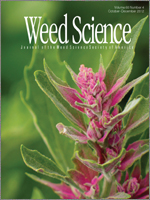Benghal dayflower is an exotic weed species in the United States that is a challenge to manage in agricultural fields. Research was conducted in North Carolina, Georgia, and Florida to evaluate the longevity of buried Benghal dayflower seeds. Seeds were buried in the field for 2 to 60 mo at a depth of 20 cm in mesh bags containing soil native to each area. In North Carolina, decline of Benghal dayflower seed viability was described by a sigmoidal regression model, with seed size having no effect on viability. Seed viability at the initiation of the study was 81%. After burial, viability declined to 51% after 24 mo, 27% after 36 mo, and < 1% after 42 mo. In Georgia, initial seed viability averaged 86% and declined to 63 and 33% at 12 and 24 mo, respectively. Burial of 36 mo or longer reduced seed viability to < 2%. The relationship between Benghal dayflower seed viability and burial time was described by a sigmoidal regression model. In Florida, there was greater variability in Benghal dayflower seed viability than there was at the other locations. Seed viability at the first sampling date after 2 mo of burial was 63%. Although there were fluctuations during the first 24 mo, the regression model indicated approximately 60% of seed remained viable. After 34 mo of burial, seed viability was reduced to 46% and then rapidly fell to 7% at 39 mo, which was consistent with the decrease in seed viability at the other locations. Although there is a physical dormancy imposed by the seed coat of Benghal dayflower, which has been detected in previous studies, it appears that a decline in buried seed viability to minimal levels occurs within 39 to 48 mo in the southeastern United States, suggesting that management programs must prevent seed production for at least four growing seasons to severely reduce the Benghal dayflower soil seedbank.
Nomenclature: Benghal dayflower, Commelina benghalensis L. COMBE.





